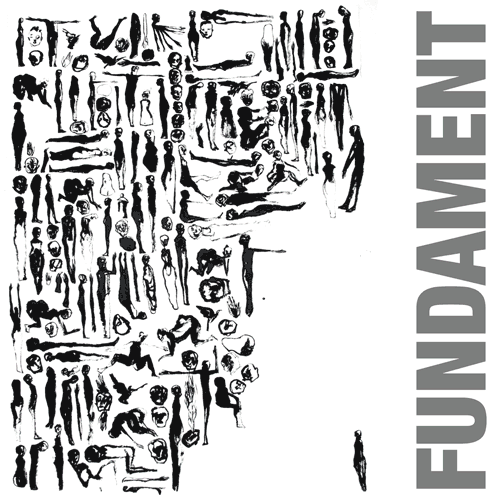
 ☰
☰
![]()


Peter Jacquemyn - double bass, voice & concept
Eric Sleichim - tubax
Yannick Peeters - double bass
Kristof Roseeuw - double bass
Lode Leire - double bass
Pieter Lenaerts - double bass & voice
Jan Pillaert - tuba & voice
Carl-Ludwich Hübsch - tuba & voice
Matthias Muche - trombone
Gregoire Tirtiaux - baritone saxophone, voice
Mathieu Lilin - baritone saxophone
Peter Verdonck - bass saxophone & voice
Recording: Jussi De Nys at Floraliënhal, Ghent
Mixing: Jussi De Nys at Nice-Recordings
Mastering: Gert Van Hoof at Coclea studios
Executive Production: Rogé Verstraete
Artwork: Peter Jacquemyn
Lay Out: Jan Pillaert
Available on CD and Vinyl
release 07/07/2018 at Gent Jazz, Belgium
(ENG)
Re: Fundament(als) - The vibrancy of air across space generated by sound bodies
The cornerstone of an ensemble like Fundament is the creation of a corporeal acoustic tour de force, via XL-sound bodies, be it strumento a fiato, a corda and corde vocali. 5 double-basses; 1 tubax, 1 bass saxophone, 1 trombone; 2 bass tuba's, 2 baritone saxophones; 5 throat-singers: all indispensable parts of the ensemble.
By using the strumento a fiato, the sound is created by the breath current causing the air column to vibrate. The power of the breath and the nature of breathing determine the vibration of the air in the body. As for the strumento a corda the sound is created through the pressure on the strings. The way of touching, the movement of the bow, the fingers on the strings are determining components of the vibration of the air in the body. What the corde vocali is concerned, the tension on the vocal chords create the sound. The breath current, the way of and the energy of the breathing cause the air to vibrate in the body.
Experiencing Fundament is an invitation to open up to a vibrating form that affects our deepest core, that evoke the infinite, arouse our imagination and creativity. Fundament's music may lead us to a place where the dream of safety is no longer valid, where the soul moves across space and, above all, where our ability to see and feel things differently is stimulated. Pregnant sounds, very concise, leave strong effects. Through alertness and condition the musicians create a fascinating sound image, a multitude of vibration, an exchange of special energies springing from the same core. They navigate the different aural terrains and depths of sound. The sounds scan the space, flock together, compete with each other, transcend themselves, regenerate into a vibrating infinity and fuse into that once primeval sound. Of paramount importance, when the vibrant air moves across space, is that the sound created is deep, full and reverberating.
Fundament aims to create a sound environment like a star system. A series of events hang across space, a series of moments with no development, a form of dialogue in which extended improvisation is not primary. The musicians are each placed at different positions of the venue and the audience is, preferably, randomly seated so vertical sound energies can be created. The project is an attempt at placing, or "route-ing" sound. Therefore using different sound lines or timbral exchanges in which different families of instruments move in synchronized directions. The musicians inner moving sound particles travel like energies across space; the sound walls are like giant searchlight beams across space.
Like, e.g., J. Cage Imaginary Landscapes, K.H. Stockhausen Zyklus, A. Braxton Composition 76 (For Trio) or 82 (For 4 Orchestras), Fundament is designed for the use of an arsenal of instruments creating extreme vocabularies of sound and using vocal improvisations and manipulations. In his notes of 76 Braxton describes Composition 76 as a temple of sound and talks of it as 'realigning a kind of ancient chant context back into our consciousness'. Like Tibetan ritual music … 'built upon the deepest vibrations that an instrument or a human voice can produce … not concerned with the emotions of temporal individuality … and consists of a number of basic sound and note patterns that can be combined and varied at will' (P.M. Hamel, Through Music to the Self, 1978).
Finally, is it remarkable that within Fundament's context the double-basses play an important role? Their play of rhythm, the percussive pluckings, the support of arco and pizzicato. The bowing screeches and rips right through one's sternum, but also envelops the whole in a warm feeling: an almost shamanistic tribal feel when the bassists accompany the repetitive bowed playing with ritual singing, producing unique harmonies using only their bodies.
Imaginary Landscapes … Zyklus … Compositions 76 and 82 … Fundament: space music conceived like an emotionally charged slow-moving dance.
Gerd Borms, Hugo de Craen (September 2017).
Press
"Don't miss it!" Stef Gijssels, Freejazzblog (10/11/2018)****1/2
"Ze zijn allemaal om bij te watertanden, maar wij smulden het meeste van nummer 1 en 3: de ingrediënten waren helemaal naar onze goesting, afgemeten gewikt en gewogen zoals alleen chef-muzikanten dat kunnen, werden heel langzaam tot op hun ideale punt gegaard..." Akim A.j. Willems, Cultuurpact (02/10/2018)
"das Ganze ist abwechslungreich, interessant und spannend." Bertl, freiStil #82 jan / feb 2019
Tweet
vinyl
SIDE A
1. FUNDAMENT - A
P. Jacquemyn - 19:04
2. blow
P. Jacquemyn - 01:49
SIDE B
1. blowblow
P. Jacquemyn - 01:30
2. FUNDAMENT - B
P. Jacquemyn - 18:23
CD
1. FUNDAMENT - A
P. Jacquemyn - 19:04
2. blow
P. Jacquemyn - 01:49
3. FUNDAMENT - B
P. Jacquemyn - 18:23
4. earth
P. Jacquemyn - 04:12
total time vinyl: 43:05
total time cd: 40:46
eNR068 © 2018
Buy CD
Buy Vinyl + download
other related or possibly interesting releases